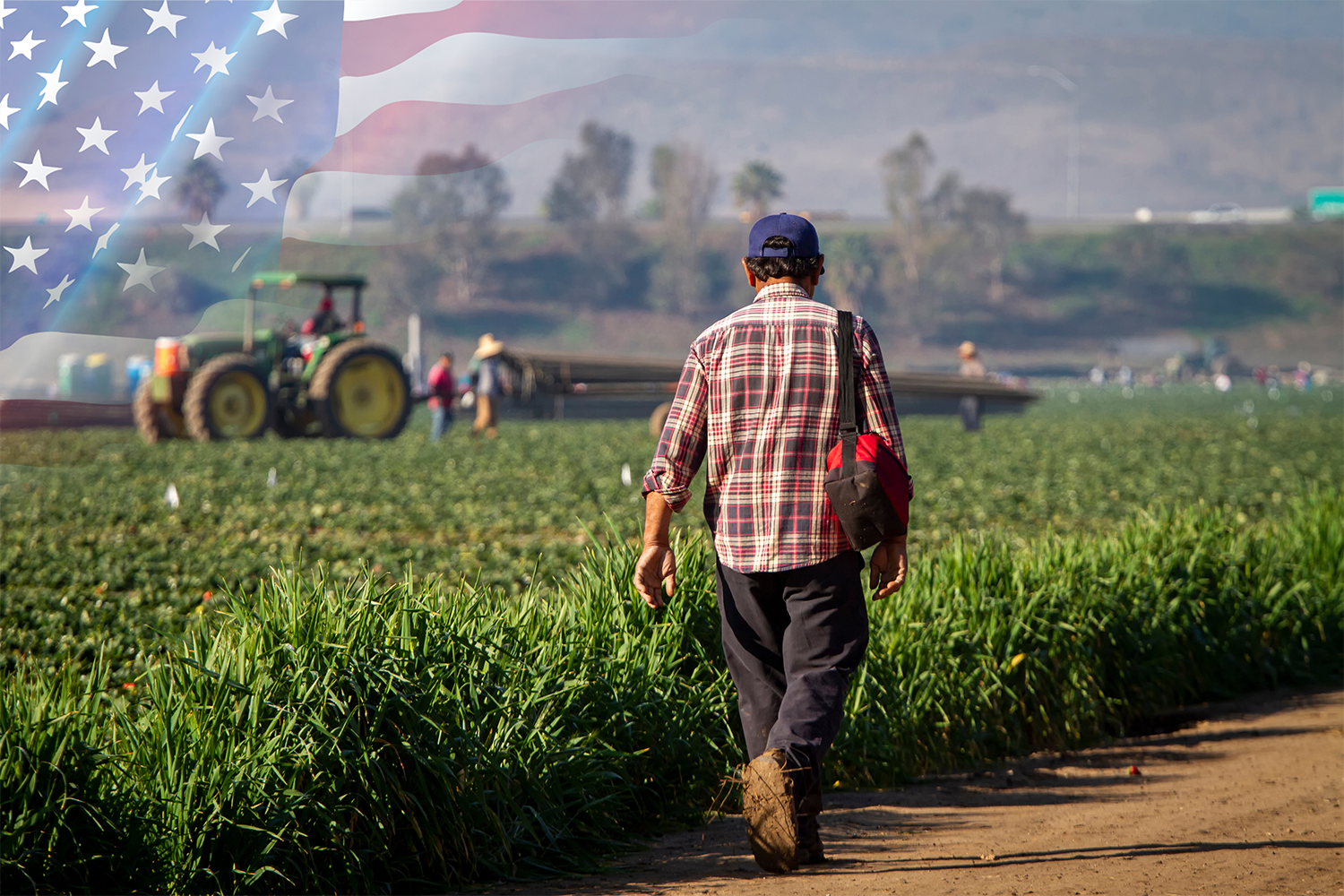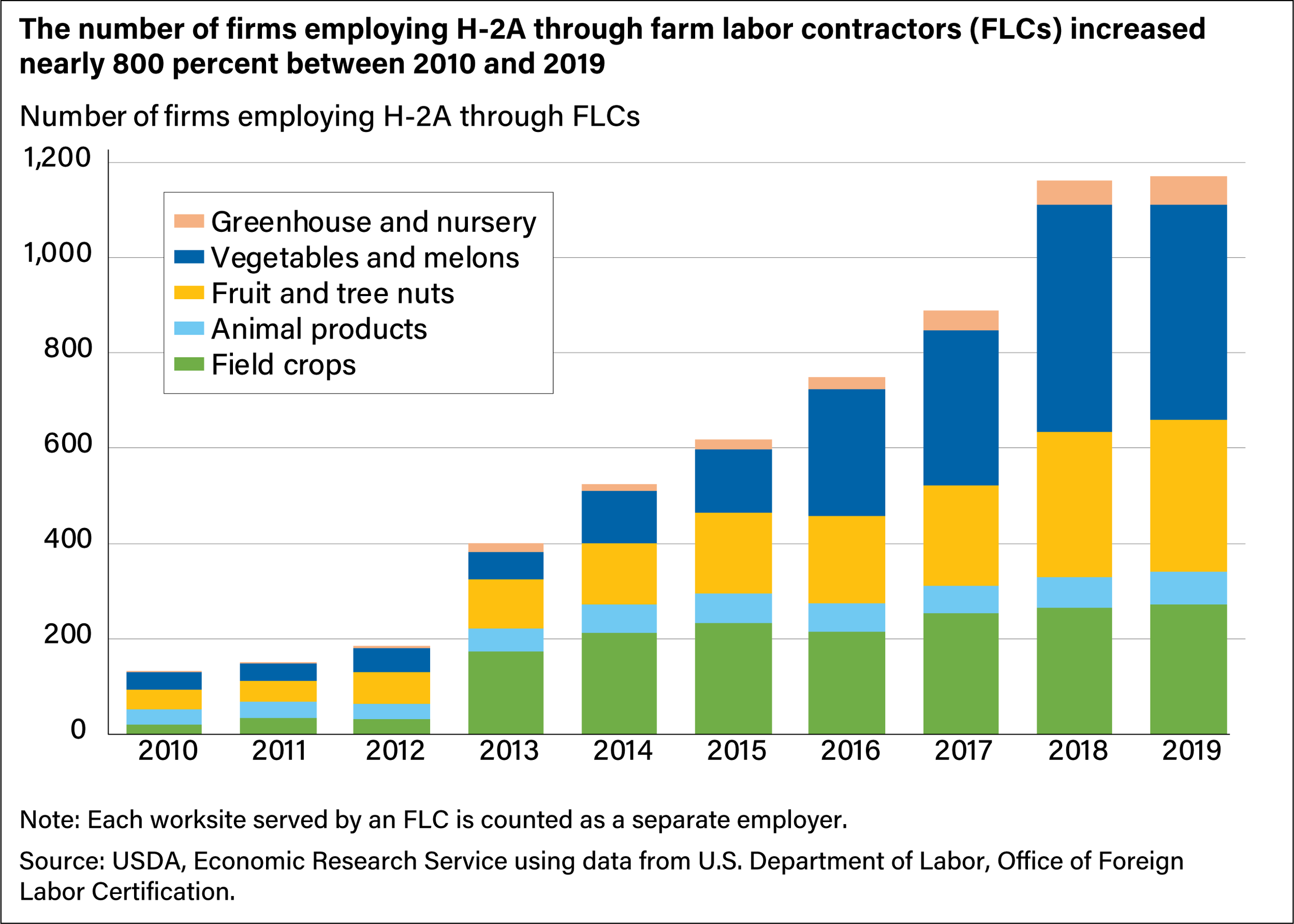The Future of U.S. Farm Labor: Is it Time to Consider H-2A?
A conversation with Nigel Bocanegra, Executive Director of the California Farm Labor Contractor Association (CFLCA)
For many employers in the agriculture industry, trying to determine crop yields and labor needs for next season can feel unpredictable. How will the weather affect my yield? Will enough farmworkers show up to harvest? Because of this uncertainty, more and more farms are turning to the H-2A Program to lean on a reliable source of labor. Nigel Bocanegra, Executive Director of the California Farm Labor Contractors Association (CFLCA), has helped many farms make the transition to include H-2A labor in their workforce. We tapped into his knowledge during our recent conversation with him, discussing what the future of farm labor looks like based on the trends he has observed.
Growth in the H-2A Program - Especially in California
“There has been spectacular growth in the H-2A program.” Nigel begins, “The number of firms that are requesting H-2A workers tripled between 2010 and 2019, and the number of firms that use H-2A workers through an FLC partner increased by 800%.” He’s right. The United States Department of Agriculture (USDA) provides more detail on this tremendous growth in research published late last year.
Nigel also identifies the massive growth in H-2A farmworkers in California, which is corroborated by the Office of Foreign Labor Certification (OFLC). In fact, the OFLC has posted data for 2022 and with 24,428 positions, California has now grown to the 2nd largest state with H-2A jobs (Florida is #1) California also has 5 of the top 10 employers based on unique Federal Employer Identification Numbers (FEINs).
“You do see some pretty incredible growth in a very short amount of time.”
Even so, with all of this growth, California is still very early on in its adoption of H-2A labor. According to research by the University of California, Davis, the western states (California, Oregon, and Washington) will likely have the fastest growth when it comes to H-2A certifications.
“You do see some pretty incredible growth in a very short amount of time. We have seen the program be used more in other parts of the country than you have in California, historically— there's been a lot of use in the southeast, [...] and so California is [...] a beast of its own compared to the rest of the country because it is such a large ag industry—such a large state.”
Below we’ll talk about what’s driving this growth—for additional information about the history of the H-2A program, refer to Ganaz’s recent article on the topic.
Labor Shortages in Agriculture
“Some of the things that are contributing to the use of H-2A workers is, of course, the labor shortage.” Nigel commented. “There's been a lot of discussion over the last year of labor shortages across the economy, but of course, there has been one in ag for quite a long time.”
“Americans just don’t raise their kids to work on farms anymore.”
“And [...] if you're a fixed site employer who needs to hire workers and you're seeing that fewer and fewer people are applying for these positions every year because Americans just don't raise their kids to work on farms anymore.”
Due to these factors, H-2A has become the go-to source for reliable labor to replace domestic farmworkers.
“[Regarding domestic farmworkers,] you're seeing the number of applications dwindle. You only have so many options to really consider to get people there [to farms]. […] The H-2A program is quite often the most obvious way of tapping into a potential workforce that you don't currently have access to. It doesn't mean that it's easy or going to be easily accessible either.”
What Nigel is referring to here is the compliance necessities of H-2A, but with very few alternatives, it is becoming more palatable for farms. “It certainly can take a long time. There's a lot of compliance that comes with it, but it is one of the only ways that you can really wrap your mind around a continuous[ly] available supply of workers.”
Beyond Mexico: Emerging H-2A Labor Markets
“We're seeing changing demographics in agricultural labor as the median age of farmworkers continues to increase over time.” The average age of domestic farmworkers has been climbing for decades and is now over 40 years old. An aging domestic workforce has led to the expansion of the H-2A program in Mexico and beyond.
“Traditionally, you could just guess that any random employee who is an H-2A worker came from Mexico because it's between 90, 95%, [...] of employees are coming from Mexico,” Nigel points out. However, as demand for foreign labor has increased, the US has started shifting its focus to new geographies.
“The Biden administration through USAID, USDA, the private sector—has been trying to help booster the H-2A programs of Guatemala, Honduras, and El Salvador, as well—as these are countries that are trying to bring more workers to the United States through legal means, like the H-2A program.”
“... a focus by the administration of ensuring employers have access to those markets.”
These programs operating in new countries have played a part in expanding H-2A labor as the benefits for farmworkers traveling to the US remain high.
“The programs are really, really impactful for their families back home. And we're seeing more of a focus by the administration of ensuring employers have access to those markets or at least considering those countries as a potential source of H-2A workers.”
While historically, very few farmworkers came from outside of Mexico, that is changing. There are now 86 countries that contribute to H-2A labor in the United States, and employers can cast a wider net to find the labor they are looking for. This leads to more cultures, backgrounds, languages, and challenges to consider when contracting for H-2A labor.
The Future of Farm Labor Contractors in the H-2A Program
As we set our sights on the future, Nigel predicts the H-2A program continues to flourish. “I think that the program will continue to grow. [...] I think we'll just continue to see a dwindling domestic worker supply that is interested in working in ag and the H-2A program is the most obvious way to go about that.”
“... continue to see a movement towards labor contractors that use H-2A employees”
Nigel also sees the roles of FLCs growing as more farmers look to labor contractors to help assist them with navigating the regulations of the H-2A program. “I mentioned that the use of H-2A labor contractors increased by 800%. I think that you will probably continue to see a movement towards labor contractors that use H-2A employees because the labor contractors already serve that role.
Nigel also foresees a growing focus on FLCs by regulators as they become more necessary to the process.
“I know that we have continued to talk about the likelihood of the Farm Workforce Modernization Act passing or not. [...] It'll probably be under discussion for a while before it's passed. But I think that there will be continuing regulation by [the] Department of Labor on H-2A labor contractors specifically.”
“... continuing regulation by Department of Labor on H-2A labor contractors specifically.”
The reason for this special attention, Nigel believes, is due to the perception that there is a diffusion of responsibility that exists between growers and FLCs when it comes to H-2A regulations.
“I do think that there is a perception in the Department of Labor that labor contractors do not comply with the regulations to the same extent or degree as fixed-site growers. So [...] they do have a special focus on labor contractors and wanting to make sure that they are truly meeting every stipulation of the program. So I think that we will see a careful eye on labor contractors.”
H-2A Housing Concerns
Speaking of fixed-site growers, Nigel does see the highest barrier to entry will continue to be the housing requirements necessary for H-2A participation, especially in California.
“Housing will always be a hot topic as well. And [...] I certainly have some concern about smaller employers in California and their ability to continually access the program because, if the cost of housing continues to rise and we continue to see [...] challenges in building more worker housing. That's only going to make it harder for smaller users of the H-2A program to access it.”
“That’s only going to make it harder for smaller users of the H-2A program to access it.”
Certain FLCs will assist with H-2A housing, but even by sharing costs, this solution does increase in price as the costs of affordable housing and lodging increase.
Mechanization vs H-2A Temporary Labor Workforce
When visualizing the technology used on farms of the future, Nigel believes that H-2A-specific labor is not easily replaceable.
“Mechanization of course is a topic that folks continue to bring up—but, […] the H-2A program will see a bit of a delay in that mechanization compared to the ag industry as a whole because we tend to see that focus [from the H-2A Program] in the labor-intensive commodities and those are just a bit more difficult to automate through mechanization. [...] That doesn't mean that there are not efforts to do that.”
Mechanization and automation can be scary concepts to hear for farmworkers who rely on labor for their livelihood, but the future Nigel is envisioning doesn’t include a complete replacement of that workforce.
“...but [automation is] not necessarily coming in to replace employees.”
“It's not necessarily mechanization that replaces workers altogether, but it is going to see more employees who are utilizing machinery or mechanization themselves that are assisting in their work, but [automation is] not necessarily coming in to replace employees. You'll see employees relying more on machinery in the work that they're doing. And in the long term, certainly, [we’ll see] a movement towards mechanization in general.”
Advice for Growers Considering H-2A to Address Labor Shortages
In summary, employers considering H-2A labor need to look at it holistically—both with the benefits and costs in mind and with a focus on finding resources that can help them manage their H-2A program.
“This is especially true for the folks who are considering the program—I know it was my experience when I first started to become familiar—I was actually a bit shocked at truly how much goes into being able to use the program, all the steps that there are when it comes to the application and process, getting approved, bringing workers to the country, let alone everything that comes with actually managing them while they're here and ensuring that you are complying with housing, meals and all of these things. It can be very daunting…”
“You can be shocked, but don’t get scared off. There are a lot of resources out there of folks who will help you...”
“[Employers] are probably shocked by what it will take. I would say don't get scared off. You can be shocked, but don't get scared off. There are a lot of resources out there of folks who will help you and ensure that you can use the program.”
And once the learning curve is overcome, Nigel says, the H-2A program is invaluable in helping growers overcome the labor challenges of our time.
“There's a reason you're seeing such rapid growth of the program. So work with agents, work with attorneys, work with associations. They all have resources to be able to help you navigate that process. So I would certainly say, look to some of the experts in the field, because there are a lot of people out there who will help you. And if you're able to set up policies and procedures, it is a way for you to really get around a lot of these challenges that employers are facing today. So don't get scared off. Look to some experts and I'm confident you'll be able to find a way to make it work for your needs.”
Resources for Hiring, Paying and Communicating with H-2As
As Nigel said, resources and partnerships are crucial to ensure your business can navigate new challenges. Many employers with H-2A farmworkers have partnered with Ganaz for Payroll Cards, HR Digital Onboarding, and Workforce Communications to ensure they can have peace of mind as they adapt to this new aspect of their operation. See what other growers like Blue River are saying about their experience with H-2As and Ganaz.
Curious about what we offer? Schedule a discovery call with our team to learn more.
About California Farm Labor Contractor Association
The California Farm Labor Contractor Association (CFLCA) provides invaluable services and benefits for farm labor contractors, growers, and affiliated organizations that serve the agriculture industry. From mandated licensing education to advocacy and labor management best practices, CFLCA supports you and your unique needs to run a successful and compliant ag operation. Their sole focus is the betterment of the farm labor contracting industry.




